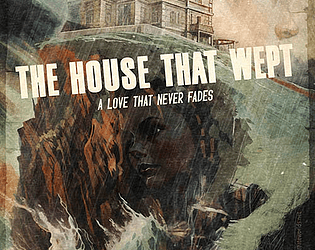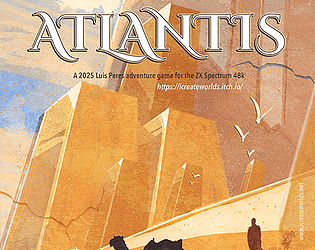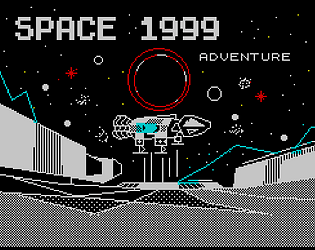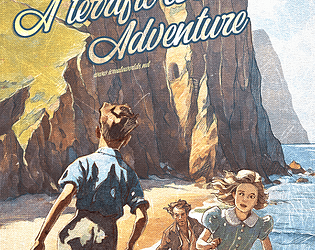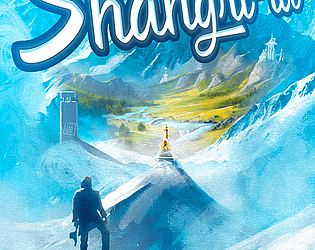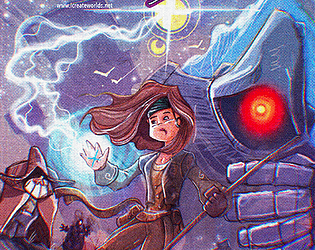I´m awaiting his reply. :)
ICreateworlds
Creator of
Recent community posts
Well, if there is a way of extending the text area size, I´ve never came across it.
"Not Lord of the Rings" to my knowledge for example, uses the same area size, as I do, but I do need to check this out now that you mention. Maybe there is a way. I just didn´t noticed before. I don´t think Play it Again Sam is GAC adventure, just based on the layout...
Hi guys, thanks for reviewing my indie ECHOES OF ATLANTIS adventure game. I get your points, and overall thank you for the support. More games to come.
Two things. The reason I have the graphics as a full screen, but only with the tiny location window for each area , is first of course because it helps to save memory but also because if I would only draw the tiny location window, that would not increase the area available for the text anyway. With GAC is always the same area, no matter you draw a lot on the location screen or you don´t. So as it does not take much memory to merge a central main illustration for each location, I do that and only draw the location area at the center.
If you guys play my ECLIPSIA or Shangri-La adventures you´ll notice I use graphics in another more colorful way, but in Echoes of Atlantis due to the "invisible" complexity for each adventure, I hardly had memory left for the basic location illustrations at the end.
I may be trying Pawn or other engines in the future, but the main reason I´m not in a hurry is because despite everything else, writing my games in GAC is a nostalgia thing for me as it takes me back to 1990 when I was doing that just for fun, never expecting someone to ever look at my games. So GAC for me is like a time machine, my Zen thing. Also as I mentioned , it´s the perfect tool to sketch the structure of an adventure that later i can take and write another book, create a comic, etc. I have some sort of an idea for a book for Echoes of Atlantis...like I did with the House that Wept or with A Terrific Weekend adventure, but I think maybe with Echoes I may create either an illustrated storybook or some sort of a graphic novel. I don´t know yet. But I didn´t write the game just thinking it would be only a ZX Game. My thing is telling stories, so everything starts like that for me.
Echoes initially was going to be just a game called Alexandria. No more. But then when I was writing the story and the game at the same time, my imagination kept opening doors that needed more expanded settings. By the time I wrote the second part, I knew I was doomed. But I never expected to write a 6 part game which took me a year to complete. And actually, I had to stop myself becaus the game was going to have a part 7. Which I still plan to write as an Epilogue for the main six part adventure. It will be a standalone adventure, hopefully with one part only, but it will be a closing of some bits I left open at the end even though players didn´t noticed them.
Anyway, once again thanks for noticing my game.
And I´m not just saying that because of it, but this magazine of yours is really special. Best speccy content I´ve came across on a ZX magazine.
Hi guys (Jamie and MPK in particular). Thanks for reviewing and enjoying my little haunted house adventure created on GAC, - THE HOUSE THAT WEPT. :)
Despite the crappy basic lineart graphic...
Maybe I should explain this for the general casual adventure games out there. ;)
The reason why the graphics are simple is because, due to the GAC’s memory limitations, after writing all the internal conditions that ensure the game’s mechanics, I’m usually left with only 2 or 3Kb to draw graphics for all the locations.
Another thing players don’t realize is that GAC consumes memory much faster with text than with graphics.
Which means that even if I gave up the simple graphics, it actually wouldn’t make a difference in the size of the descriptions, and I couldn’t use that memory to expand the text.
Just writing a single paragraph would use up those 3Kb. So it’s always better to spend those 3Kb on drawings — no matter how simple they are, they always help the player get oriented — rather than spending 3Kb on text that would disappear in just one or two sentences.
What players don’t know in my GAC adventures is that 70% of the 21Kb of memory I have for each game is always used on programming logic conditions that ensure the structure has no gaps.
I have to anticipate things, actions, or words that the player might try to type, even if they never end up using them.
There’s a lot of complex logic behind the apparent simplicity that the player sees on screen. And that’s where almost all of the game’s memory goes. Then about 25% goes into the short descriptions which, even though they’re telegraphic, still use up a lot of memory with each sentence. Sometimes I even have to decide whether or not to add a comma in a description, because even that small detail will cost memory in bytes that I might need later for a detail in an image.
The remaining 5% of memory — after descriptions and programming — if I’m lucky, goes toward graphics. In this case, and in my most recent adventures, they’re purely functional.
In my adventures Shangri La and Eclipsia, the graphics looked better because the narrative structure of those games was simpler to program. There were fewer things in the story structure I had to account for, and fewer things I knew players might try to type that would cause an error. In these newer games, because the worlds are more open, the number of invisible conditions I had to create has quadrupled.
In my most recent adventures, where I try to create a more open map with freedom of movement beyond just the puzzles — like A Terrific Weekend Adventure or Echoes of Atlantis — most of the memory was taken up by internal logic conditions to ensure the player could explore as freely as possible without getting stuck in or by a puzzle.
Above all, what interests me in my games is telling stories.
In fact, the initial texts are much more complex than the telegraphic descriptions used in the adventures, because I usually end up writing a book based on those ideas.
So that’s why my most recent games have basic graphics, but they also don’t need to be purely text-based games.
Text uses a lot of memory in GAC, whether it’s description text or internal condition text.
So for me, the real challenge is creating a narrative within 21Kb.
Besides, I love GAC because it’s an excellent notepad for planning book structures that can become games — or vice versa: ZX games that can become books.
--
On a personal note here, aimed at my Portuguese audience that keeps asking me the same obvious question I need to explain...
The reason I always write in English ( and do NOT do games in Portuguese at all ) actually comes down to two things:
The main one is that I use the games to promote my illustration website, www.icreateworlds.net, which is where my daily work comes from.
But the second reason I always write in English and not Portuguese — which I could easily do — is very simple, and something most people wouldn’t even imagine.
It’s that, in terms of memory, writing using GAC in English uses less memory than writing in Portuguese — or probably in Spanish too, since they’re similar languages. Let me explain.
For example, the verb get in English uses 2 bytes, but the same verb in Portuguese, apanhar, has twice as many letters, which means it uses 6 bytes. Now imagine this difference across the entire game. There are sentences in English that use between 10 to 12 bytes, but their Portuguese equivalents might use between 30 and 60 bytes — just to say the same thing.
It’s all because the sentence structure of the English language is much simpler and more economical in how it conveys information.
That’s why GAC is great for writing adventures in English, but not at all suited for Iberian languages.
In terms of memory, GAC is simply not designed for large adventures in any language other than English.
For that reason, when people ask me when I’ll have a Portuguese version of my games, the answer is that they probably wouldn’t even fit in GAC if translated. So instead of doing a simple translation, I’d actually need to rewrite the entire game from scratch to "convert" the internal structure itself, adapting it to Portuguese and how it uses memory so extremely.
In fact, just the direct translation would almost double the memory used compared to the English version.
All my games use GAC memory to the absolute limit. For example, in The House That Wept, I had just 1 byte left.
The worst thing about GAC is that when you go over the available memory, the program crashes and can even destroy the entire code. You have to be very careful, and everything has to be thought out down to the last byte to make sure that doesn’t happen.
And when I normally have only 2 to 3K per game to sometimes draw graphics for 30 to 50 locations, it becomes very hard to manage.
And that’s it.
Once again, thank you for talking about my game. More are on the way, and I think this helps people better understand the reasoning behind my visual choices — the kind of decisions people never imagine when they see the visual simplicity of the final result.
One day I may try to create an adventure using some other thing other than GAC,
but for now I love it because its the perfect "sketchbook" to plan stories. Super fast to program, simple to structure a story that can be converted easily into a book and it gives me the same joy as it did back in 1990.
In short, thanks for enjoying the game. And check out my other games.
--
Keep that magazing going. I love the variety of content you included and it´s super informative.
Hi there! Thanks. It´s cool you´ve enjoyed the game for what I tried to do.
Actually...
The reason why the graphics are simple is because, due to the GAC’s memory limitations, after writing all the internal conditions that ensure the game’s mechanics, I’m usually left with only 2 or 3K to draw graphics for all the locations.
Another thing players don’t realize is that GAC consumes memory much faster with text than with graphics.
Which means that even if I gave up the simple graphics, it actually wouldn’t make a difference in the size of the descriptions, and I couldn’t use that memory to expand the text.
Just writing a single paragraph would use up those 3K. So it’s always better to spend those 3K on drawings — no matter how simple they are, they always help the player get oriented — rather than spending 3K on text that would disappear in just one or two sentences.
What players don’t know in my GAC adventures is that 70% of the 21K of memory I have for each game is always used on programming logic conditions that ensure the structure has no gaps.
I have to anticipate things, actions, or words that the player might try to type, even if they never end up using them.
There’s a lot of complex logic behind the apparent simplicity that the player sees on screen. And that’s where almost all of the game’s memory goes. Then about 25% goes into the short descriptions which, even though they’re telegraphic, still use up a lot of memory with each sentence. Sometimes I even have to decide whether or not to add a comma in a description, because even that small detail will cost memory in bytes that I might need later for a detail in an image.
The remaining 5% of memory — after descriptions and programming — if I’m lucky, goes toward graphics. In this case, and in my most recent adventures, they’re purely functional.
In my adventures Shangri La and Eclipsia, the graphics looked better because the narrative structure of those games was simpler to program. There were fewer things in the story structure I had to account for, and fewer things I knew players might try to type that would cause an error. In these newer games, because the worlds are more open, the number of invisible conditions I had to create has quadrupled.
In my most recent adventures, where I try to create a more open map with freedom of movement beyond just the puzzles — like A Terrific Weekend Adventure or Echoes of Atlantis — most of the memory was taken up by internal logic conditions to ensure the player could explore as freely as possible without getting stuck in or by a puzzle.
Above all, what interests me in my games is telling stories.
In fact, the initial texts are much more complex than the telegraphic descriptions used in the adventures, because I usually end up writing a book based on those ideas.
So that’s why my most recent games have basic graphics, but they also don’t need to be purely text-based games.
Text uses a lot of memory in GAC, whether it’s description text or internal condition text.
So for me, the real challenge is creating a narrative within 21K.
Besides, I love GAC because it’s an excellent notepad for planning book structures that can become games — or vice versa: ZX games that can become books.
In short, thanks for enjoying it. More to follow. :)
Im the oposite. Back,in the day in the 80s i was always looking for text adventures for the spectrum. My all time favorite was The Neverending Story which i p,ayed for endless hours. Since then i got hooked on text adventures and those arecwhat i love to do. Thanks for trying this one. Download the walkthrough and just enjoy the story. 😎
Cool. Thank you. And thanks for getting the book too. Don´t expect a literary masterpiece. It´s just a novelization of the game with a few things added like I did for my other game A Terrific Weekend Adventure. As I write my games mostly as books it would be a waste not to create the companion books to go along too.
Leave a review later. Even if you don´t enjoy the book, it does not matter as with Amazon even 1 star reviews help the books contrary to what people may think. It helps Amazon to notice that people are interacting with the book page. So when you see those reviews that take down products and you ever wondered why Amazon is interested in having people talk bad about one of their products its because of that. Any interaction with a book in Amazon will level up the product in their search engine exposing it to more potential clients. So no matter you see 5 stars in there or 1 star, to the ranking system its the same, and to any author is actually the same too. as it helps with the search engine. ;)
And as you have bought the book, don´t forget to download the game too. :)
Thanks
Ah, no, there are no dead ends at all.
You don´t need to restart any of my games if you are stuck somewhere. It took a lot of "invisible" memory for me to write conditions to make sure that would never happen.
Generally there´s a couple of different paths you can take to solve a problem. I make my worlds free enough that you don´t have to solve a specific puzzle to advance. For example you can solve puzzle A and then B and C, but you can also solve puzzle C first , then A, then B if you want.
All my puzzles are confined in small areas with just a couple of them extending the entire game.
But if you reach some place and you don´t have a clue what to do , or nothing you try works, that is why you need a specific object that you didn´t noticed was there.
My adventures because of the narrative structure have about three spots where you can only pass if you solved the other riddles in that specific area. You will never get stuck in a place where you cannot go back to where you have been, because I know many people miss my hidden objects. So the goal is always allow people to explore even back to the beginingin of the game if they have too.
For example in this one, there´s hidden stuff right inside room 1 in part 6 of the game. And I know many people start the adventure and then have to come back inside "the Vimana" to retrieve that important object. So there´s always a way to go back to anywhere you have explored already in the game.
Download the game Walkthrough. If you get stuck, search for the solution for that bit in there. ;)
Thanks for playing.
Yup the images are there just as visual guide. Unfortunately I only have 21K ( yes, really Kbytes...not megas or gigabytes ;) ), to do every game and from those about 19 K need to go into the actual game and so that leaves me about 2K at the most to "illustrate" between 25 and 60 locations, which have to take about 5 to 10 bytes each one, so no room for beautiful graphics on the Zx Spectrum if I want to write complex adventures as I do. But I´m still experimenting.
I didn´t knew there was a good Android ZX Spectrum emulator that actually really worked well out there. Thanks.
It´s fascinating to see the game running like that on Android too. :)
Well, you either download the .tap files, upload them to a pendrive ( with any other zx spectrum game in .tap or .tzx ) and connect it to the brand new ZX Spectrum computer that just came out last November in its brand new 2025 version which includes a lot of new options for 2025 users.
OR...
You can go here : https://worldofspectrum.net/emulators/
Choose a ZX Spectrum emulator.
I do recommend this one ( called Fuse ) : https://fuse-emulator.sourceforge.net/
Install it on any computer, download my files (.tap) and run those inside the ZX Spectrum emulator anywhere. :)
Thanks for trying it out. Tip, exam stuff. Sometimes theres stuff hidden inside stuff. 😁 Theres an important thing to pick up at the beach. 😎 That will get you inside the library when you show your find to the gate guard. 😁😇
I recommend you download the walkthrough pdf. The game is huge so if you follow the first chapter solution you will find your way easier through the second chapter. 😎
Hi everyone.
Do you love classic ZX Spectrum adventure games?
Have you bought the new The Spectrum and you are looking for brand new adventure games, created recently for you ZX ? ;)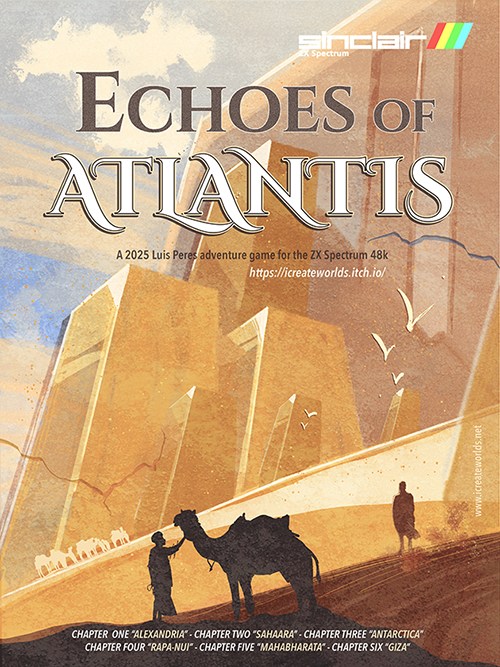
This is my new one. A forbidden archeology adventure created between December of 2023 and January of 2025.
It took me forever because initially it was suposed to be just a simple game about the library of Alexandria in ancient times, but then the story grew out of proportions and it took me more than a year to complete all the chapters. :)
I´m an illustrator and so it was really hard to find the time between my professional projecs to complete this one, but I just did it. So here it is. Free of charge.
Check out my new game "ECHOES of ATLANTIS" which you can find here: Echoes of Atlantis for the ZX Spectrum - Free Download
Trailer here:
If you enjoy this one, don´t forget to download my other ZX Spectrum adventure games on my page https://icreateworlds.itch.io/
Thanks ! More to come. ;)
By the way it´s fascinating to see how people get stuck in places where I didn´t thought they would. :)
Hint..... you can "talk" to characters and you missed at least 2 vital hidden objects almost at the start too. Although you died when trying to pass the first Guardian in the woods, you already carried the right object to defeat him.
It´s fun to see how my distractions are actually working. You past 2 very important objects without even remember to examine vital set pieces in the environment. ;)
Try again. :)
Thanks DVDfever! I'm having lots of fun creating this stuff. More to come ... this week.... :)
If you want all the Eclipsia maps, you can get them at the Portuguese review page here: https://planetasinclair.blogspot.com/2023/12/eclipsia.html?fbclid=IwAR3-_xZU-eIu...
Although, part of the fun in these old school style adventures is drawing the maps ourselves. But if you get stuck somewhere maybe the original maps will help. The game has been tested in a ton of possible gameplay solutions and so far no bugs. :)


